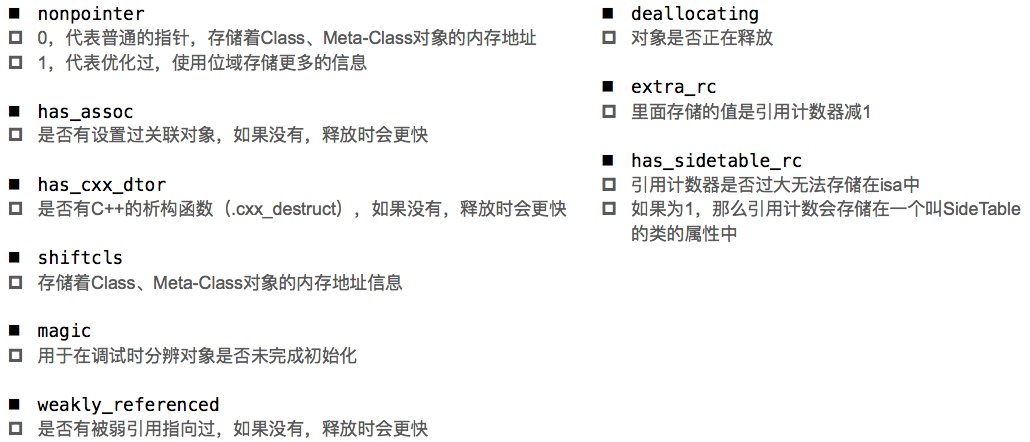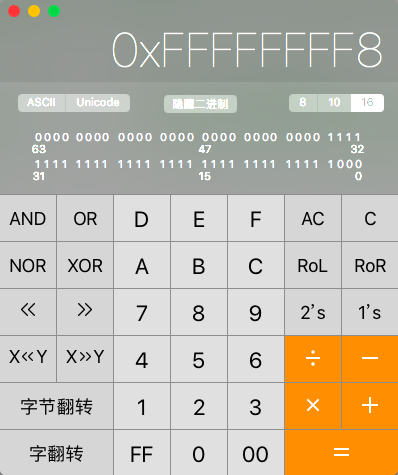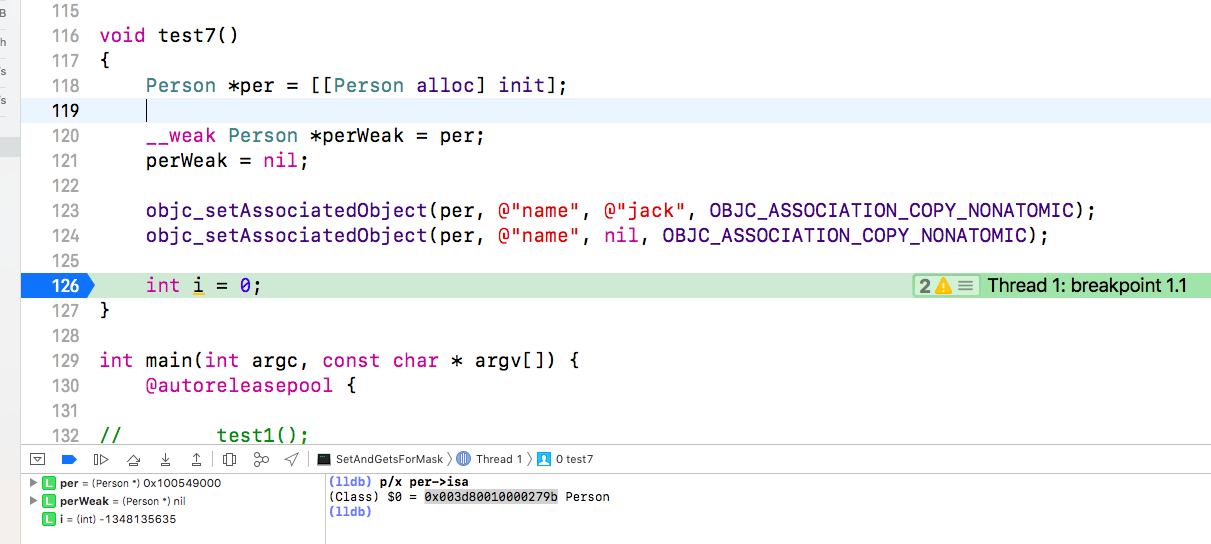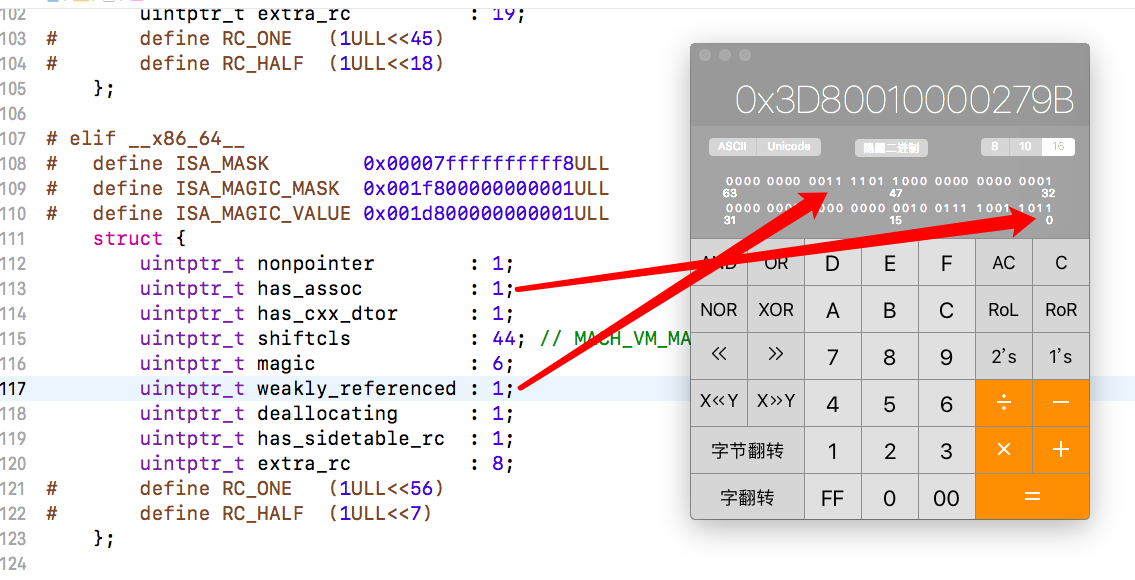一、isa指针结构
union isa_t { isa_t() { } isa_t(uintptr_t value) : bits(value) { } Class cls; uintptr_t bits; #if SUPPORT_PACKED_ISA // extra_rc must be the MSB-most field (so it matches carry/overflow flags) // nonpointer must be the LSB (fixme or get rid of it) // shiftcls must occupy the same bits that a real class pointer would // bits + RC_ONE is equivalent to extra_rc + 1 // RC_HALF is the high bit of extra_rc (i.e. half of its range) // future expansion: // uintptr_t fast_rr : 1; // no r/r overrides // uintptr_t lock : 2; // lock for atomic property, @synch // uintptr_t extraBytes : 1; // allocated with extra bytes # if __arm64__ # define ISA_MASK 0x0000000ffffffff8ULL # define ISA_MAGIC_MASK 0x000003f000000001ULL # define ISA_MAGIC_VALUE 0x000001a000000001ULL struct { uintptr_t nonpointer : 1; uintptr_t has_assoc : 1; uintptr_t has_cxx_dtor : 1; uintptr_t shiftcls : 33; // MACH_VM_MAX_ADDRESS 0x1000000000 uintptr_t magic : 6; uintptr_t weakly_referenced : 1; uintptr_t deallocating : 1; uintptr_t has_sidetable_rc : 1; uintptr_t extra_rc : 19; # define RC_ONE (1ULL<<45) # define RC_HALF (1ULL<<18) }; # elif __x86_64__ # define ISA_MASK 0x00007ffffffffff8ULL # define ISA_MAGIC_MASK 0x001f800000000001ULL # define ISA_MAGIC_VALUE 0x001d800000000001ULL struct { uintptr_t nonpointer : 1; uintptr_t has_assoc : 1; uintptr_t has_cxx_dtor : 1; uintptr_t shiftcls : 44; // MACH_VM_MAX_ADDRESS 0x7fffffe00000 uintptr_t magic : 6; uintptr_t weakly_referenced : 1; uintptr_t deallocating : 1; uintptr_t has_sidetable_rc : 1; uintptr_t extra_rc : 8; # define RC_ONE (1ULL<<56) # define RC_HALF (1ULL<<7) }; # else # error unknown architecture for packed isa # endif // SUPPORT_PACKED_ISA #endif #if SUPPORT_INDEXED_ISA # if __ARM_ARCH_7K__ >= 2 # define ISA_INDEX_IS_NPI 1 # define ISA_INDEX_MASK 0x0001FFFC # define ISA_INDEX_SHIFT 2 # define ISA_INDEX_BITS 15 # define ISA_INDEX_COUNT (1 << ISA_INDEX_BITS) # define ISA_INDEX_MAGIC_MASK 0x001E0001 # define ISA_INDEX_MAGIC_VALUE 0x001C0001 struct { uintptr_t nonpointer : 1; uintptr_t has_assoc : 1; uintptr_t indexcls : 15; uintptr_t magic : 4; uintptr_t has_cxx_dtor : 1; uintptr_t weakly_referenced : 1; uintptr_t deallocating : 1; uintptr_t has_sidetable_rc : 1; uintptr_t extra_rc : 7; # define RC_ONE (1ULL<<25) # define RC_HALF (1ULL<<6) }; # else # error unknown architecture for indexed isa # endif // SUPPORT_INDEXED_ISA #endif };
分析:
1.我们知道,实例对象的isa指针指向该对象所属类的类对象;类对象的isa指向其元类对象;
2.真机为arm64架构,模拟器和mac电脑为x86架架构,以下以arm64为例讲解;
3.在64位系统下,指针所占字节为8个即64位;
4.在arm64之前,isa就是一个普通的指针,存放着类(元类)对象的地址;之后,则需要&
ISA_MASK掩码,才能获取到类(元类)对象的地址,此时isa指针为一个共用体,存储的信息不局限于类(元类)对象的地址;
5.存储信息介绍:

其中,shiftcls结构体成员变量(33位)用来存储类(元类)对象的地址;
二、类(元类)对象的地址取值原理——位域
1.结构体支持位域运算
//代码
struct bs { unsigned a : 9;//如果超过位域范围(511),则只取范围内的值,其他位(高位)丢弃 unsigned b : 4; unsigned c : 3; }bit, *pbit; void test1() { bit.a = 512;//超过位域范围报警告 bit.b = 10; bit.c = 7; NSLog(@"%d,%d,%d ", bit.a, bit.b, bit.c); pbit=&bit; pbit-> a=0; pbit-> b&=3; pbit-> c|=1; printf("%d,%d,%d ",pbit-> a,pbit-> b,pbit-> c); }

//输出
2019-10-08 18:22:37.051464+0800 SetAndGetsForMask[1966:248996] 0,10,7 0,2,7 Program ended with exit code: 0
//分析
1)unsigned即无符号整型,占4个字节;结构体中成员变量所占内存相互独立且连续;
2)以a为例,所占位数为9位即0b111111111(十进制511),所以a的取值范围0~511,如果是512(二进制0b1000000000),由于只取低9位(000000000),所以取出值为0;
3)按位与&:两个都为1运算结果为1,否则为0;按位或|:两个都为0运算结果为0,否则为1;
2.参照isa,共用体套用结构体,一个char字符(一个字节)存储多个BOOL值并制定存储位置
2.设置类属性BOOL值(setter and getter)
//Person
#import "Person.h" //mask即掩码,表示二进制数(0b开头) #define TallMask (1<<0) //表示1左移0位:0b 0000 0001 #define RichMask (1<<1) //表示1左移1位:0b 0000 0010 #define HandsomeMask (1<<2) //表示1左移2位:0b 0000 0100 //拓展:10<<3即在10对应的二进制数后添加3个0 @interface Person() { char _saveBox; } @end @implementation Person - (instancetype)init { if (self = [super init]) { //用一个字节来存储三个变量:从最右往左依次为Tall、Rich、Handsome _saveBox = 0b00000101; } return self; } /*思路 0000 0101(_saveBox) |0000 0001(掩码) --------- 0000 0001(赋值tall为1) 0000 0101 &1111 1110(掩码取反) --------- 0000 0100(赋值tall为0) 1.如果赋的值为1,则按位或; 2.如果赋的值为0,则掩码先取反,后按位与; */ - (void)setTall:(BOOL)tall { if (tall) { _saveBox |= TallMask; } else { _saveBox &= ~TallMask; } } - (void)setRich:(BOOL)rich { if (rich) { _saveBox |= RichMask; } else { _saveBox &= ~RichMask; } } - (void)setHandsome:(BOOL)handsome { if (handsome) { _saveBox |= HandsomeMask; } else { _saveBox &= ~HandsomeMask; } } /*思路 0000 0101 &0000 0001 --------- 0000 0001(取出tall值) 1.按位与,用掩码取出_saveBox中特定位; 2.结果>=1,取反为0,再取反为1;同理,为0则双取反后为0; */ - (BOOL)isTall { return !!(_saveBox & TallMask); } - (BOOL)isRich { return !!(_saveBox & RichMask); } - (BOOL)isHandsome { return !!(_saveBox & HandsomeMask); } @end
//Student
#import "Student.h" @interface Student() { /*思路 1.用一个结构体来存放变量; 2.结构体支持位域:按先后顺序,一个char字符一个字节(0b0000 0000),从最右至左依次为tall、rich、handsome; */ struct { char tall : 1;//用一位来存储 char rich : 1; char handsome : 1; }_tallRichHandsome; } @end @implementation Student - (void)setTall:(BOOL)tall { _tallRichHandsome.tall = tall; } - (void)setRich:(BOOL)rich { _tallRichHandsome.rich = rich; } - (void)setHandsome:(BOOL)handsome { _tallRichHandsome.handsome = handsome; } - (BOOL)isTall { return !!_tallRichHandsome.tall;//非0(包括负数)取反为0 } - (BOOL)isRich { return !!_tallRichHandsome.rich; } - (BOOL)isHandsome { return !!_tallRichHandsome.handsome; } @end
//Worker
#import "Worker.h" #define TallMask (1<<0)//也可以左移6位,剩余位没用到 #define RichMask (1<<1) #define HandsomeMask (1<<2) #define ThinMask (1<<3) @interface Worker() { //苹果系统设计思路 union { char bits;//一个字节存储结构体中的所有成员变量 struct {//摆设用:位域,增加可读性 char tall : 1;//占一位 char rich : 1; char handsome : 1; char thin : 1; }; }_tallRichHandsome; } @end @implementation Worker - (void)setTall:(BOOL)tall { if (tall) { NSLog(@"----%c", _tallRichHandsome.bits); _tallRichHandsome.bits |= TallMask; } else { _tallRichHandsome.bits &= ~TallMask; } } - (void)setRich:(BOOL)rich { if (rich) { _tallRichHandsome.bits |= RichMask; } else { _tallRichHandsome.bits &= ~RichMask; } } - (void)setHandsome:(BOOL)handsome { if (handsome) { _tallRichHandsome.bits |= HandsomeMask; } else { _tallRichHandsome.bits &= ~HandsomeMask; } } - (void)setThin:(BOOL)thin { if (thin) { _tallRichHandsome.bits |= ThinMask; } else { _tallRichHandsome.bits &= ~ThinMask; } } - (BOOL)isTall { return !!(_tallRichHandsome.bits & TallMask); } - (BOOL)isRich { return !!(_tallRichHandsome.bits & RichMask); } - (BOOL)isHandsome { return !!(_tallRichHandsome.bits & HandsomeMask); } - (BOOL)isThin { return !!(_tallRichHandsome.bits & ThinMask); } @end
//main
#import <Foundation/Foundation.h> #import "Person.h" #import "Student.h" #import "Worker.h" #import "Engineer.h" struct bs { unsigned a : 9;//如果超过位域范围(511),则只取范围内的值,其他位(高位)丢弃 unsigned b : 4; unsigned c : 3; }bit, *pbit; void test1() { bit.a = 512;//超过位域范围报警告 bit.b = 10; bit.c = 7; NSLog(@"%d,%d,%d ", bit.a, bit.b, bit.c); pbit=&bit; pbit-> a=0; pbit-> b&=3; pbit-> c|=1; printf("%d,%d,%d ",pbit-> a,pbit-> b,pbit-> c); } void test2() { Person *per = [[Person alloc] init]; per.tall = NO; per.rich = NO; per.handsome = YES; NSLog(@"%d %d %d", per.isTall, per.isRich, per.isHandsome); } void test3() { Student *stu = [[Student alloc] init]; stu.tall = YES; stu.rich = NO; stu.handsome = YES; NSLog(@"%d %d %d", stu.isTall, stu.isRich, stu.isHandsome); } void test4() { Worker *worker = [[Worker alloc] init]; // worker.tall = YES; worker.rich = NO; worker.handsome = NO; worker.thin = YES; NSLog(@"%d %d %d", worker.isThin, worker.isRich, worker.isHandsome); } void test5() { Engineer *engineer = [[Engineer alloc] init]; // engineer.age = 12; // engineer.level = 6; // engineer.workers = 5; //0b 1111 1111 1111 1111(十进制:65535) //0b 0010 1100 1110 1101(十进制:11501) engineer->_personalInfo.bits =11501; NSLog(@"%d %d %d", engineer.getAge, engineer.getLevel, engineer.getWorkers); //2019-10-08 16:42:09.612140+0800 SetAndGetsForMask[1488:127227] 7 16 8160 // } int main(int argc, const char * argv[]) { @autoreleasepool { test1(); // test2(); // test3(); // test4(); // test5(); } return 0; }
//打印
2019-10-09 10:42:04.998750+0800 SetAndGetsForMask[2513:316066] 0 0 1 2019-10-09 10:42:04.999093+0800 SetAndGetsForMask[2513:316066] 1 0 1 2019-10-09 10:42:04.999122+0800 SetAndGetsForMask[2513:316066] 1 0 0 Program ended with exit code: 0
//分析(以Worker为例)
1)共用体中所有成员共同占用一块内存区,其大小等于最大那个成员所占字节数;
2)Worker中的结构体并为定义变量,编译器不会计算其内存,仅是增加可读性;
3)Worker中只有一个char型变量bits(占一个字节),故该共用体变量_tallRichHandsome也占一个字节;
4)结构体的位域限制变量的取值范围(一位:即0或1),mask掩码规定该变量存储的位置(在哪一位上);
3.设置类属性非BOOL类型(setter and getter)——限定变量值范围且指定存储位置
//Engineer
#import <Foundation/Foundation.h> NS_ASSUME_NONNULL_BEGIN //位域位置(变量值存储位置) #define AgeMask 0b00000111//最低三位存储 #define LevelMask (1<<4)//低位往高位数,第5位存储 #define WorkersMask 0b0001111111100000 @interface Engineer : NSObject { @public union { int bits; struct {//位域范围(变量值范围) int age : 3; int level : 1; int workers : 8; }; }_personalInfo; } //- (void)setAge:(int)age; //- (void)setLevel:(int)level; //- (void)setWorkers:(int)workers; - (int)getAge; - (int)getLevel; - (int)getWorkers; @end NS_ASSUME_NONNULL_END #import "Engineer.h" @implementation Engineer //- (void)setAge:(int)age //{ // self->_personalInfo.bits |= AgeMask; //} // //- (void)setLevel:(int)level //{ // self->_personalInfo.bits |= LevelMask; //} // //- (void)setWorkers:(int)workers //{ // self->_personalInfo.bits |= WorkersMask; //} - (int)getAge { return self->_personalInfo.bits & AgeMask; } - (int)getLevel { return self->_personalInfo.bits & LevelMask; } - (int)getWorkers { return self->_personalInfo.bits & WorkersMask; } @end
//打印
2019-10-09 11:08:14.617655+0800 SetAndGetsForMask[2630:349068] 5 0 3296 Program ended with exit code: 0
//说明
1)掩码mask既可以直接用二进制(0b开头)或十六进制(0x开头)表示,也可以左移符号<<表示(一般用于位域为1的情况);
2)掩码表示所占位数:1表示占住该位,0未占;并且所占位数应当是连续的,不存在两侧为1,中间为0的情况;
三、按位或(叠加)
typedef NS_OPTIONS(NSUInteger, UIViewAutoresizing) { UIViewAutoresizingNone = 0, UIViewAutoresizingFlexibleLeftMargin = 1 << 0, UIViewAutoresizingFlexibleWidth = 1 << 1, UIViewAutoresizingFlexibleRightMargin = 1 << 2, UIViewAutoresizingFlexibleTopMargin = 1 << 3, UIViewAutoresizingFlexibleHeight = 1 << 4, UIViewAutoresizingFlexibleBottomMargin = 1 << 5 }; self.view.autoresizingMask = UIViewAutoresizingFlexibleWidth | UIViewAutoresizingFlexibleRightMargin;
1.分析:在iOS中,对view的自动布局经常会用到上述代码,苹果的做法是定义个枚举且每种类型都只占不同的一个二进制位,按位或相当于设定的场景都要考虑到;
2.如下代码:
typedef enum{ YBOptionTypeNone = 0, //0b0000 YBOptionTypeOne = 1<<0, //0b0001 YBOptionTypeTwo = 1<<1, //0b0010 YBOptionTypeThree = 1<<2, //0b0100 YBOptionTypeFour = 1<<3 //0b1000 }YBOptionType; void test6(YBOptionType option) { /*按位或叠加(包含多种情况),按位与取出(获得特定情况) 0b0001 0b0100 | 0b1000 ---------- 0b1101 & 0b0100 ---------- 0b0100 */ if (option & YBOptionTypeOne) { NSLog(@"contain YBOptionTypeOne"); } if (option & YBOptionTypeTwo) { NSLog(@"contain YBOptionTypeTwo"); } if (option & YBOptionTypeThree) { NSLog(@"contain YBOptionTypeThree"); } if (option & YBOptionTypeFour) { NSLog(@"contain YBOptionTypeFour"); } } int main(int argc, const char * argv[]) { @autoreleasepool { // test1(); // test2(); // test3(); // test4(); // test5(); test6(YBOptionTypeOne | YBOptionTypeThree | YBOptionTypeFour); } return 0; }
//打印
2019-10-22 21:55:17.154998+0800 SetAndGetsForMask[996:46994] contain YBOptionTypeOne 2019-10-22 21:55:17.155318+0800 SetAndGetsForMask[996:46994] contain YBOptionTypeThree 2019-10-22 21:55:17.155332+0800 SetAndGetsForMask[996:46994] contain YBOptionTypeFour Program ended with exit code: 0
四、结论
1.arm64之后,isa是一个共用体类型的指针,存储内部套用的结构体中的所有成员变量;
2.根据结构体的位域来限制成员变量的值范围,用掩码来规定成员变量存储的位置,对掩码按位与运算取出特定位置的成员变量的值;
如:用bits对ISA_MASK按位与运算后,得到的是类(元类)对象的地址;

可以看到shiftcls成员变量位域为33位,所占bits变量的存储位置为:地位到高位第四位起,最低三位是空出来的
————因此,在arm64架构中,所有的类和元类对象地址二进制表示时最低三位都为0,十六进制表示时最低一位为0或8(这个用class和object_getClass去打印地址,此处不再展示了)!
3.按位与作用为在集合中取出某个特定值,按位或则将若干个特定值集合到一个值中(即所有设定场景都要考虑到);
拓展:
//代码

//计算器演示

//分析
1.模拟器为x86_64架构,64位指针占八个字节;在结构体中,自上而下的变量在isa中的存储位置为从低位到高位即计算器中下到上、左到右——这点应该没问题;
2.per实例对象曾经被弱指针指向过(现在释放了),且曾经关联过对象(现在置空),而对应的位为1即表示确实曾经被弱指针指向过(如果没有则会为0),曾经关联过对象;所以
has_assoc和weakly_referenced分别表示对象曾经被弱指针指向过和曾经关联过对象——其他变量分析以此类推;